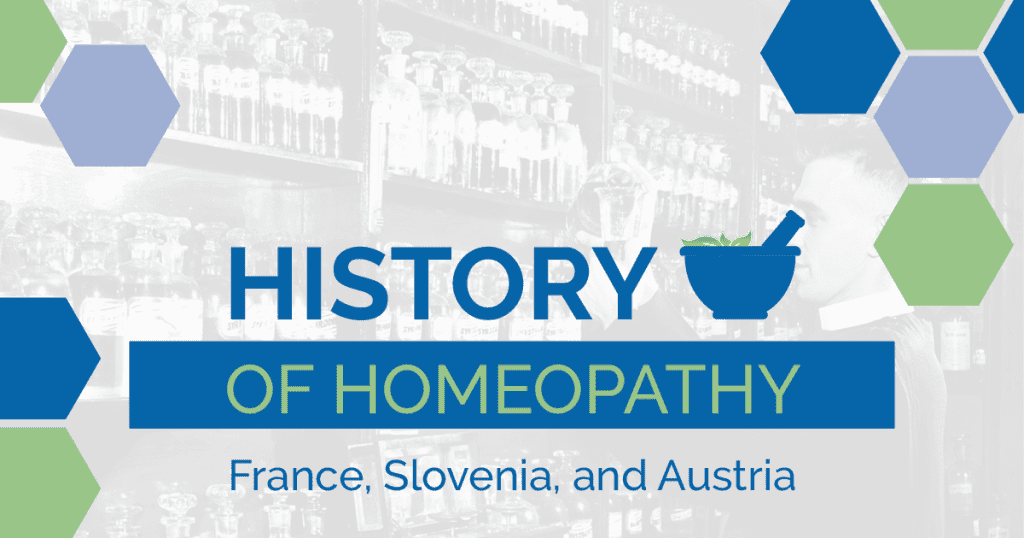Snapshots from There and Then: History of Homeopathy

In honor of AAHP’s 100th anniversary year, we’re looking back at the history of homeopathy to learn how the medical modality spread worldwide. Readers will discover startling vignettes of unexpected paths and outcomes. Many may know much about homeopathy here and now, but we hope you find our “There and Then” series informative and interesting!
France
The wife of an inspector of the University of Lyon was treated by homeopaths while visiting Italy. Based on its impressive success, this inspector traveled to Germany, studied with Hahnemann, and returned to Lyon (1830) where he began practicing homeopathy. The first homeopathic pharmacy opened in Paris (1833), with some hospitals in the same city utilizing homeopathic medicines in 1847. Despite internal divisions and differences of approach, the spread of homeopathy was quick and wide-ranging with favorable acceptance and integration during the succeeding two centuries. It still retains a high degree of patient acceptance in France. A recent study indicates that 30% of patients undergoing cancer treatment use homeopathy for palliative care in addition to the treatment for their disease, making this discipline by far the most widely used medical practice in integrative oncology. This represents an increase of 83% compared to a similar study in 2005.
Monographed homeopathic drug products are available OTC, but many are not in the Pharmacopoeia, including all the newly proven remedies and some lesser-used ones.
Previously patients who purposed medicines that were “prescribed” by physicians were reimbursed by the national health insurance. Two years ago, that reimbursement was stopped, causing an economic impact on users and producers of homeopathic products. In response, the first French network was formed to bring together patient associations, health professionals, teachers, researchers, and drug manufacturers. The goal was to find solutions for responsible and sustainable medicine. Homeopathy in France remains very dynamic.
Slovenia
There was a long tradition of Slovenia’s consumer use of homeopathic products, both by aristocrats and commoners. Despite it being illegal through the 19th century for pharmacies to stock homeopathic products, there are accounts that at least one pharmacy actively prepared homeopathic medicines. The clergy, especially in rural areas, were a primary source of information on homeopathic products and prescribing of it. Most rural areas had multiple copies of handbooks written for the laity.
Recently the laws stated licensed medical doctors were forbidden to prescribe homeopathic medicines. A group of medical doctors challenged this, resulting in a slow change to allow doctors to prescribe. All the regulatory maneuvering has taken place despite the EU Directive on the registration of homeopathic drugs having been adopted into Slovenian law a decade earlier, and registration permits for some homeopathic drugs having been issued soon thereafter.
Austria
Homeopathy has been present in Austria since soon after Hahnemann’s discovery of homeopathy. The successes with the 1831 cholera epidemic led to the practice being legalized in 1837. Yet over the next few decades, the number of practitioners remained low. Going into the 20th century, only a handful of doctors were actively practicing, but use was increasingly adopted by priests, pastors' wives, and lay persons.
After WWII, a doctor and a pharmacist couple made contacts with other interested professionals and opened communications with those in other counties. This led to an international homeopathic congress in Salzburg. Four decades later, the Austrian national association had about 1,000 doctors. There are efforts and discussions to integrate homeopathy into the national health system. Despite approximately 70% of patients choosing homeopathy as their preferred complementary medical modality, the public health insurance does not cover these treatments, though a number of private insurance companies do. There are two domestic manufacturers and other EU companies’ products are easily available.
References:
https://www.wholehealthnow.com/homeopathy_pro/france.html
https://www.sciencedirect.com/science/article/abs/pii/S1878973018301610
https://1796web.com/thesis/1930.html
https://homeopathyeurope.org/regulatory-status/slovenia/
https://www.wholehealthnow.com/homeopathy_pro/austria.html
